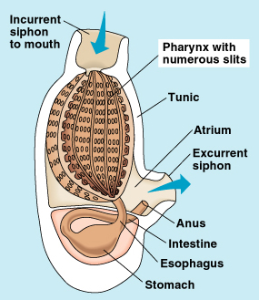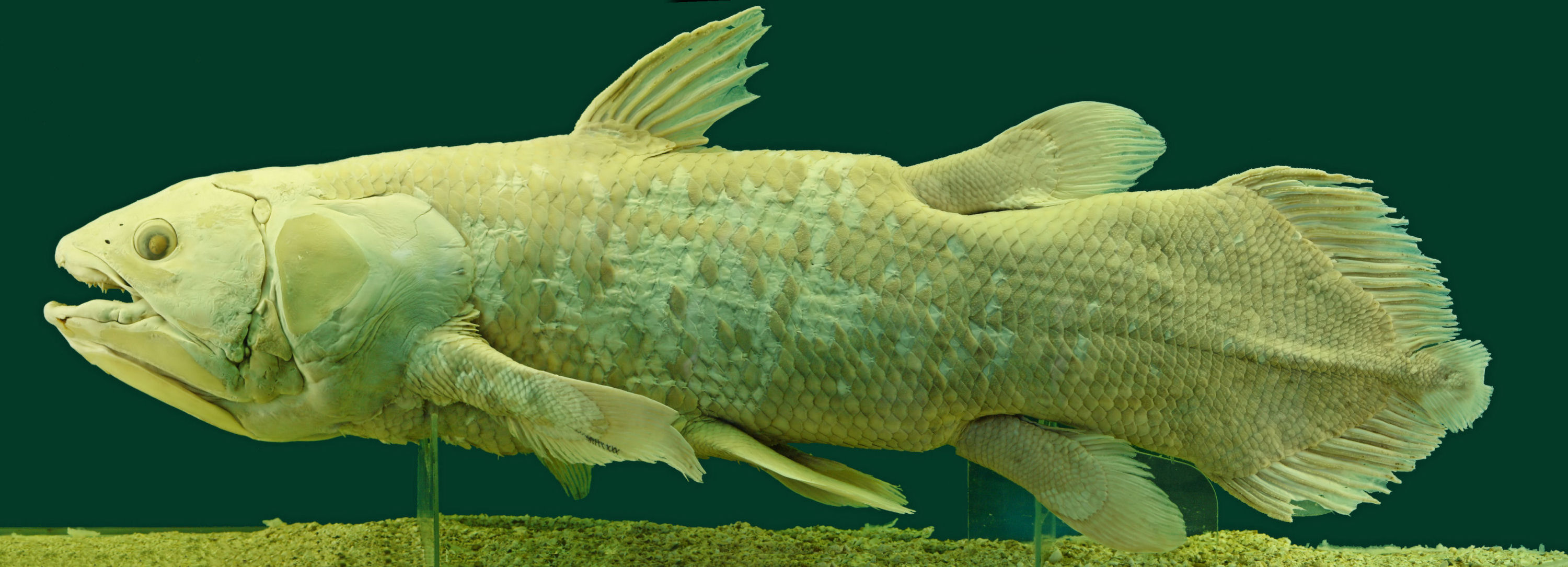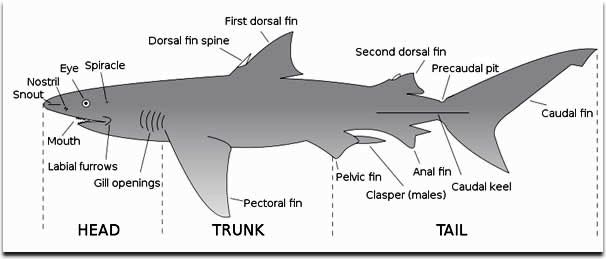Phylum Chordata, Hemichordata, Super Class Pisces
Table of Content |
|
|
Phylum Chordata
General Characters of Phylum Chordata

 (1) Aquatic, aerial or terrestrial. All free-living with no fully parasitic forms.
(1) Aquatic, aerial or terrestrial. All free-living with no fully parasitic forms.
(2) Body small to large, bilaterally symmetrical and metamerically segmented.
(3) A post anal tail usually projects beyond the anus at some stage and may or may not persist in the adult.
(4) Exoskeleton often present; well developed in most vertebrates.
(5) Body wall triploblastic with 3 germinal layers : ectoderm, mesoderm and endoderm.
(6) Coelomate animals having a true coelom, enterocoelic or schizocoelic in origin.
(7) A skeletal rod, the notochord, present at some stage in life cycle.
(8) A cartilaginous or bony, living and jointed endoskeleton present in the majority of members (vertebrates).
(9) Pharyngeal gill slits present at some stage; may or may not be functional.
(10) Digestive system complete with digestive glands.
(11) Blood vascular system closed. Heart ventral with dorsal and ventral blood vessels. Hepatic portal system well developed.
(12) Excretory system comprising proto-or meso- or meta-nephric kidneys.
(13) Nerve cord dorsal and tubular. Anterior end usually enlarged to form brain.
(14) Sexes separate with rare exceptions.
Difference between Lower and Higher Chordates
Group A. Acrania (Protochordata) or Lower Chordata |
Group B. Craniata (Euchordata) or Higher Chordata |
|
Exclusively marine, small-sized chordates |
Aquatic or terrestrial, mostly large sized vertebrates |
|
No appendages, cephalization and exoskeleton
|
Usually 2 pairs of appendages, well-developed head and exoskeleton present |
|
Coelom enterocoelic, budding off from embryonic archenteron. |
Coelom schizocoelic, arising by splitting of mesoderm |
|
Notochord persistent. No skull, cranium and verterbral column |
Notochord covered or replaced by a vertebral column. Skull and cranium well developed. |
|
Phyrynx with permanent gill clefts. Endostyle present |
Phraryngeal gill clefts persist or disappear Endostyle absent |
|
Heart chamber less when present. No. red blood corpuscles in blood |
Heart made of 2, 3 or 4 chambers. Blood contains R.B.C |
|
Kidneys protonephridia |
Kidneys meso– or metanephric |
|
Sexes separate or united. Reproduction asexual as well as sexual. Gonoducts usually absent |
Sexes separate. Only sexual reproduction, Gonoducts always present |
|
Development indirect with a free-swimming larval stage |
Development indirect or direct, with or without a larval stage |
|
Division I. Agnatha |
Division II. Gnathostomata |
|
Without true jaws |
|
|
Paired appendages absent |
Appendages paired (pectoral & pelvic) |
|
Inner ear with 2 semi-circular canals. |
Inner ear with 3 semi-circular canals |
|
Notochord persistent in adults |
Classification of Chordata
Phylum chordata can be divided into two groups: Acrania (Protochordata) and Craniata (Euchordata) having contrasting characters.
Group A. Acrania (Protochordata)
-
(Gr. a, absent; kranion, head, or, Gr. protos, first; chorde, cord)
-
All marine, small, Primitive or lower chordates.
-
Lacking a head, a skull or cranium, a vertebral column, jaws and brain.
-
About 2,000 species.
-
The Acrania is divided into three subphyla: Hemichordata, Urochordata and Cephalochordata, chiefly on the character of notochord present.
Subphylum I. Hemichordata
-
Body divided into 3 regions: Proboscis, collar and trunk.
-
Notochord doubtful, short, confined to proboscis and non–homologous with that of chordates.
-
Class 1. Enteropneusta
-
(Gr. enteron, gut; pneustos, breathed). Body large and worm-like.
-
Gill slits numerous.
-
Intestine straight.
-
Acorn or togue worms.
-
70 species.
-
Balanoglossus, Saccoglossus.
Class 2. Pterobranchia
-
(Gr. pteron, feather; branchion, gill).
-
Body small and compact.
-
Gill-slits one pair or none.
-
Intstine U–shaped. Pterobranchs.
-
20 species.
-
Cephalodiscus, Rhabdopleura.
Subphylum II. Urochordata or Tunicata 
-
(Gr. oura, a tail; L. chorda, cord).
-
Notochord and nerve cord only in tadpole-like larva.
-
Adult sac-like, often sessile and encased in a protective tunic.
-
Tunicates.
Class 1. Ascidacea
-
Sessile tunicates with scattered muscles in tunic.
-
Solitary, colonial or compound.
-
Gill-clefts numerous.
-
Ascidians or sea squirts.
-
1,200 species.
-
Herdmania, ciona, Molgula.
-
Retrogressive metamorphosis present in Herdmania.
Class 2. Thaliacea
-
Free-swimming or pelagic tunicates with circular muscles in tunic.

-
Sometimes colonial.
-
Salps or chain tunicates.
-
30 species.
-
Salpa, Doliolum, Pyrosoma.
Subphylum III. Cephalochordata
-
(Gr. kephale, head; L. chorda, cord).
-
Notochord and nerve cord present throughout life along entire length of body.
Class Leptocardii
-
Body fish-like, segmented with distinct myotomes and numerous gill-slits.
-
Free swimming and burrowing.
-
Lancelets.
-
30 species.
-
Branchiostoma (= Amphioxus), Asymmetron.
Group B. Craniata (Euchordata)
-
Aquatic or terrestrial, usually large-sized, higher chordates or vertebrates with distinct head, a vertebral column, jaws and brain protected by a skull or cranium.
-
The Craniata includes a single subphylum, the vertebrata.
Subphylum IV. Vertebrata
-
(L. vertebratus, backbone).
-
Notochord supplemented or replaced by a vertebral column or backbone composed of overlapping vertebrae.
-
Body divisible into head, neck, trunk and tail.
-
Usually dioecious.
-
Vertebrates, largest chordate subphylum including about 46,500 species.
-
The subphylum Vertebrata is divided into two divisions: Agnatha and Gnathostomata, with contrasting characters as follows:
Division I. Agnatha
-
(Gr. a, not; gnathos, jaw).
-
Jaw less primitive fish-like vertebrates without true jaws and paired limbs.
Class 1. Ostracodermi
-
(Gr. ostrakon, shell; derma, skin).
-
Several extinct orders of ancient primitive heavily armoured, Palaeozoic, world's first vertebrates, collectively called the ostracoderms.
-
Caphalaspis, Drepanaspis.
Class 2. Cyclostomata
-
(Gr. cyklos, circular; stoma, mouth).
-
Body eel-shaped, without scales, jaws and lateral fins.
-
Mouth rounded and suctorial.
-
Gills 5–16 pairs.
-
Parasites and scavengers.
-
45 species.
-
Lampreys (Petromyzon) and hagfishes (Myxine).
Division II. Gnathostomata
-
(Gr. gnathos, jaw; stoma, mouth).
-
Jawed vertebrates having true jaws and paired limbs.
-
For convenience, some taxonomists further divide Gnathostomata division into two super classes.
-
All the fishes like aquatic gnathostomes are placed in the superclass Pisces, whereas all the four-footed terrestrial gnathostomes in the superclass Tetrapoda.
-
Their contrasting features are as follows:
Superclass 1. Pisces |
Superclass 2. Tetrapoda |
|
Exclusively aquatic gnathostome vertebrates. |
Aquatic or terrestrial. Some arboreal and aerial |
|
Paired limbs, if present, as fins. |
Paired pentadactyle limbs present |
|
Median fins present |
Median fins absent |
|
Skin usually moist and scaly |
|
|
Respiration aquatic, by gills |
Respiration aerial, by lungs |
|
Sense organs functional in water |
|
|
It consist of fishes only. |
It consist of classes Amphibia, Reptilia, Aves and Mammals. |
Superclass Pisces
Class 1. Chondrichthyes (Cartilaginous Fishes)
General Characters of Chondrichthyes
(1) Mostly marine and predaceous.
(2) Body fusiform or spindle shaped.
(3) Fins both median and paired, all supported by fin rays. Pelvic fins bear claspers in male. Tail heterocercal.
(4) Skin tough containing minute placoid scales and mucous glands.
(5) Endoskeleton entirely cartilaginous, without true bones (Gr. chondros, cartilage + ichthys, fish). Notochord persistent. Vertebrae complete and separate. Pectoral and pelvic girdles present.
(6) Mouth ventral. Jaws present. Teeth are modified placoid scales. Stomach J-shaped. Intestine with spiral valve.
(7) Respiration by 5 to 7 pairs of gills. Gill-slits separate and uncovered. Operculum absent. No air bladder and lungs.
(8) Heart 2–chambered (1 auricle and 1 ventricle). Sinus venosus and conus arteriosus present. Both renal and portal systems present. Temperature variable (poikilothermous).
(9) Kidneys opisthonephric. Excretion ureotelic. Cloaca present.
(10) Brain with large olfactory lobes and cerebellum. Cranial nerves 10 pairs.
(11) Olfactory sacs do not open into pharynx. Membranous labyrinth with 3 semicircular canals. Lateral line system present.
(12) Sexes separate. Gonads paired. Gonoducts open into cloaca. Fertilization internal. Oviparous or ovoviviparous. Eggs large, yolky. Cleavage meroblastic. Development direct, without metamorphosis.
Classification of Chondrichthyes
(a) Subclass I. Selachii : (Gr., selachos, a shark)
(1) Multiple gill slits on either side protected by individual skin flaps.
(2) A spiracle behind each eye.
(3) Cloaca present.
(4) Examples :
- True sharks. About 250 living species.
- Dogfishes (Scoliodon, Chiloscyllium, Mustelus, Carcharinus)
- Spiny dogfish (squalus) seven gilled shark (Heptanchus)
- Zebra shark (stegostoma), hammer-headed (Sphyrna), whale shark (Rhineodon). Skates and rays. About 300 species. Skate (Raja), stingray (Trygon), electric ray (Tropedo), eagle ray (Myliobatis), guitar fish (Rhinobatus), sawfish (Pristis)
- Electric organ are found in Torpedo
(b) Subclass 2. Holocephali : (Gr., holos, entire + kephale, head)
(1) Single gill opening on either side covered by a fleshy operculum.
(2) No spiracles, cloaca and scales.
(4) Single nasal opening.
(5) Lateral line system with open groove.
(6) Examples : Rat fishes or chimaeras. About 25 species. Hydrolagus (= Chimaera).
Class 2. Osteichthyes (Bony fishes)
General Characters of Osteichthyes
(1) Inhabit all sorts of water-fresh, brackish or salt; warm or cold.
(2) Body spindle-shaped and streamlined.
(3) Fins both median and paired, supported by fin rays of cartilage or bone. Tail usually homocercal.
(4) Skin with may mucous glands, usually with embedded dermal scales of 3 types; ganoid, cycloid or ctenoid. Some without scales. No placoid scales.
(5) Endoskeleton chiefly of bone (Gr., osteon, bone + ichthyes, fish). Cartilage in sturgeons and some other. Notochord replaced by distinct vertebrae Pelvic girdle usually small and simple or absent. Claspers absent.
(6) Mouth terminal or sub terminal. Jaws usually with teeth. Cloaca lacking, anus present.
(7) Respiration by 4 pairs of gill on body gill arches, covered by a common operculum on either side.
(8) An air (swim) bladder often present with or without duct connected to pharynx. Lung-like in some (Dipnoi).
(9) Ventral heart 2-chambered (1 auricle + 1 ventricle). Sinus venosus and conus arteriosus present. Aortic arches 4 pairs. Erythrocytes oval, nucleated. Temperature variable (poikilothermous).
(10) Adult kidneys mesonephric. Excretion ureotelic.
(11) Brain with very small olfactory lobes, small cerebrum and well developed optic lobes and cerebellum. Cranial nerves 10 pairs.
(12) Well developed lateral line system. Internal ear with 3 semicircular canals.
(13) Sexes separate. Gonads paired. Fertilization usually external. Mostly oviparous, rarely ovoviviparous or viviparous. Eggs minute to 12 mm. Cleavage meroblastic. Development direct, rarely with metamorphosis.
Classification of Osteichthyes
(a) Subclass I. Sarcopterygii :
(Gr., sarcos, fleshy + pterygium, fin)
(1) Paired fins leg-like or lobed. With a fleshy, bony central axis covered by scales.
(2) Dorsal fins 2. Caudal fin hreterocercal with an epichordal lobe.
(3) Olfactory sacs usually connected to mouth cavity by internal nostrils or choanae, hence the previous name of subclass, choanichthyes (Gr., choana, funnel + ichthyes, fish).
(4) Popularly called fleshy or lobe-finned, or air breathing fish. Divided into 2 superorders or orders: Crossopterygii and Dipnoi.
Order 1. Crossopterygii
(Gr., crossoi, a fringe + pteryx, fin)
(1) Paired fins lobate. Caudal fin 3–lobed.
(2) Premaxillae and maxillae present.
(3) Internal nares present or absent. Spiracles present.
(4) Air bladder vestigial.
(5) Example– Primitive fleshy-finned extinct fishes. Single living genus Latimeria.
Order 2. Dipnoi
(Gr., di, double + pnoe, breathing)
(1) Median fins continuous to form diphycercal tail.
(2) Premaxillae and maxillae absent.
(3) Internal nares present and spiracles absent.
(4) Air bladder single or paired, lung-like
(5) Examples – Lung fishes. Only 3 living genera : Epiceratodus (Neoceratodus), Protopterus and Lepidosiren
(b) Subclass II. Actinopterygii
(Gr., actis, ray + pteryx, fin)
(1) Paired fins thin, broad, without fleshy basal lobes, and supported by dermal fin rays.
(2) One dorsal fin, may be divided.
(3) Caudal fin without epichordal lobe.
(4) Olfactory sacs not connected to mouth cavity.
(5) Popularly called ray-finned fishes. Divided into 3 infaclasses or superorders: Chondrostei, Holostei and Teleostei.
Superorder A. Chondrostei
(Gr., chondros, cartilage + osteon, bone)
(2) Scales usually ganoid.
(3) Tail fin heterocercal.
(4) Primitive ray-finned fish or cartilaginous ganoids.
(5) Examples – Acepenser (Sturgeon), Polyodon (paddlefish)
Superorder B. Holostei
(Gr., holos, entire + osteon, bone)
(1) Mouth opening small.
(2) Ganoid or cycloid scales.
(3) Tail fin heterocercal.
(4) Intermediate ray-finned fish, transitional between Chondrostei and Teleostei
(5) Examples –Lepisosteus (garpike)
Superorder C. Teleostei
(Gr., teleos, complete + osteon, bone)
(1) Mouth opening terminal, small.
(2) Scales cycloid, ctenoid or absent.
(3) Tail fin mostly homocercal.
(4) A hydrostatic swim bladder usually present.
(5) Advanced or modern ray-finned fishes
(6) Examples – Harpodon (Bombay duck), Cyprinus (carp), Labeo rohita (rohu), Catla, Botia, Carassius (Goldfish), Clarius (Magur), Heteropneustes or Saccobranchus (singhi), Wallago (lachi), Mystus (tengra), Electrophorus (electric eel) Anguilla (freshwater eel), Muraena (moray) Hemirhamphus (half beak), Belone (garfish), Hippocampus (sea horse), Syngnathus (pipe fish), Fistularia (flute fish) Ophiocephalus or channa (snake head) Amphipbnous, Symbranchus (eels). Mastacembelus, Macrognathus, Pterois (scorpion fish), Pleuronectes, Synaptura, Solea, Echeneis or Remora (sucker fish), (porcupine fish), Tetrodon (globe fish)
Related Resources
-
Click here to refer the Useful Books of Biology for NEET (AIPMT)
-
Click here for study material on Anatomy of Flowering Plants
To read more, Buy study materials of Animal Kingdom comprising study notes, revision notes, video lectures, previous year solved questions etc. Also browse for more study materials on Biology here.
View courses by askIITians


Design classes One-on-One in your own way with Top IITians/Medical Professionals
Click Here Know More

Complete Self Study Package designed by Industry Leading Experts
Click Here Know More

Live 1-1 coding classes to unleash the Creator in your Child
Click Here Know More

a Complete All-in-One Study package Fully Loaded inside a Tablet!
Click Here Know MoreAsk a Doubt
Get your questions answered by the expert for free




